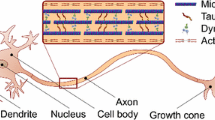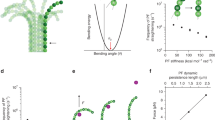Abstract
This work concerns efficient and reliable numerical simulations of the dynamic behaviour of a moving-boundary model for tubulin-driven axonal growth. The model is nonlinear and consists of a coupled set of a partial differential equation (PDE) and two ordinary differential equations. The PDE is defined on a computational domain with a moving boundary, which is part of the solution. Numerical simulations based on standard explicit time-stepping methods are too time consuming due to the small time steps required for numerical stability. On the other hand standard implicit schemes are too complex due to the nonlinear equations that needs to be solved in each step. Instead, we propose to use the Peaceman–Rachford splitting scheme combined with temporal and spatial scalings of the model. Simulations based on this scheme have shown to be efficient, accurate, and reliable which makes it possible to evaluate the model, e.g. its dependency on biological and physical model parameters. These evaluations show among other things that the initial axon growth is very fast, that the active transport is the dominant reason over diffusion for the growth velocity, and that the polymerization rate in the growth cone does not affect the final axon length.












Similar content being viewed by others
References
Diehl, S., Henningsson, E., Heyden, A., & Perna, S. (2014). A one-dimensional moving-boundary model for tubulin-driven axonal growth. Journal of Theoretical Biology, 358, 194–207.
Douglas, J. (1955). On the numerical integration of \(\frac {\partial ^{2} u} {\partial x^{2}} + \frac {\partial ^{2} u}{\partial y^{2}} = \frac {\partial u} {\partial t}\) by implicit methods. Journal of the Society for Industrial and Applied Mathematics, 3(1), 42–65.
García, J.A., Peña, J.M., McHugh, S., & Jérusalem, A. (2012). A model of the spatially dependent mechanical properties of the axon during its growth. CMES – Computer Modeling in Engineering and Sciences, 87 (5), 411–432.
Graham, B.P., & van Ooyen, A. (2006). Mathematical modelling and numerical simulation of the morphological development of neurons. BMC Neuroscience, 7(Suppl. 1).
Graham, B.P., Lauchlan, K., & McLean, D.R. (2006). Dynamics of outgrowth in a continuum model of neurite elongation. Journal of Computational Neuroscience, 20(1), 43–60.
Hansen, E., & Henningsson, E. (2013). A convergence analysis of the Peaceman–Rachford scheme for semilinear evolution equations. SIAM Journal on Numerical Analysis, 51(4), 1900– 1910.
Hundsdorfer, W., & Verwer, J. (2003). Numerical solution of time-dependent advection-diffusion-reaction equations, Springer series in computational mathematics Vol. 33. New York: Springer.
Kiddie, G., McLean, D., Ooyen, A.V., & Graham, B. (2005). Biologically plausible models of neurite outgrowth. In van Pelt, J, Kamermans, M, Levelt, C N, van Ooyen, A, Ramakers, G J A, & Roelfsema, P R (Eds.), Development, dynamics and pathiology of neuronal networks: from molecules to functional circuits, progress in brain research, (Vol. 147 pp. 67–80): Elsevier.
McLean, D.R., & Graham, B.P. (2004). Mathematical formulation and analysis of a continuum model for tubulin-driven neurite elongation. Proceedings Royal Society A: Mathematical, Physical and Engineering Sciences, 460(2048), 2437–2456.
McLean, D.R., & Graham, B.P. (2006). Stability in a mathematical model of neurite elongation. Mathematical Medicine and Biology – A Journal of the IMA, 23(2), 101–117.
McLean, D.R., van Ooyen, A., & Graham, B.P. (2004). Continuum model for tubulin-driven neurite elongation. Neurocomputing, 58–60, 511–516.
Miller, K.E., & Heidemann, S.R. (2008). What is slow axonal transport? Experimental Cell Research, 314 (10), 1981–1990.
Peaceman, D.W., & Rachford, H.H. (1955). The numerical solution of parabolic and elliptic differential equations. Journal of the Society for Industrial and Applied Mathematics, 3(1), 28–41.
Sadegh Zadeh, K., & Shah, S.B. (2010). Mathematical modeling and parameter estimation of axonal cargo transport. Journal of Computational Neuroscience, 28(3), 495–507.
Smith, D.A., & Simmons, R.M. (2001). Models of motor-assisted transport of intracellular particles. Biophysical Journal, 80(1), 45–68.
Suter, D.M., & Miller, K.E. (2011). The emerging role of forces in axonal elongation. Progress in Neurobiology, 94(2), 91–101.
van Ooyen, A. (2011). Using theoretical models to analyse neural development. Nature Reviews Neuroscience, 12(6), 311– 326.
Walker, R.A., O’Brien, E.T., Pryer, N.K., Soboeiro, M.F., Voter, W.A., Erickson, H.P., & Salmon, E.D. (1988). Dynamic instability of individual microtubules analyzed by video light microscopy: rate constants and transition frequencies. Journal of Cell Biology, 107(4), 1437–1448.
Acknowledgments
The authors thank the reviewers for valuable suggestions, in particular, the idea to investigate the scaling with respect to diffusion.
Author information
Authors and Affiliations
Corresponding author
Ethics declarations
Conflict of interests
The authors declare that they have no conflict of interest.
Additional information
Communicated by: Action Editor: Erik De Schutter
E. Henningsson was supported by the Swedish Research Council under grant no. 621-2011-5588.
Appendices
Appendix A: Proof of Lemma 1
We begin by noting that any positive definite matrix is invertible and that any square matrix is positive definite when its symmetric part has only positive eigenvalues. That is, the linear system of Eqs. (23) has a unique solution when the eigenvalues of
are all positive. The entries of the main diagonal, respectively the super and sub diagonals are given as follows
Thus, S(U n+1/2,y) is a symmetric, tridiagonal Toeplitz matrix meaning that the eigenvalues are given by the following formula
Then, any λ k fulfils the following inequality
By plugging in the entries and using the triangle inequality we get
where we have used the definition of γ given by Eq. (24). We conclude that the eigenvalues of S(U n+1/2,y) are positive when
and therefore, for these values of Δτ, the system (23) has a unique solution.
Appendix B: Two-dimensional slices of Figs. 2b and 8
We complement the three-dimensional plots (Figs. 2b and 8) with two-dimensional slices at different x and t values. Recall that in Fig. 2b the tubulin concentration along the axon is plotted for nominal values on the biological and physical parameters. For Fig. 8 a three times larger advection velocity a is used. The slices of Figs. 2b and 8 are presented next to each other in Figs. 13, 14, 15 and 16 for easy comparison.
Slices of Fig. 2b at three different x values and at the growth cone. Note that the spatial position of the latter changes with time. The spikes in the second and third subfigures correspond to times where the respective slice is close to the cone. Further, note that the concentration in the growth cone is largely unaffected by the soma concentration, instead a higher value in the latter results in a longer axon
Slices of Fig. 8 at three different x values and at the growth cone. As the three times larger advection velocity a gives a far longer axon, different x values are chosen compared to those in Fig. 13. Note how the higher advection velocity gives smaller concentration values in the inner of the axons; the tubulin is concentrated close to the soma and the growth cone
Rights and permissions
About this article
Cite this article
Diehl, S., Henningsson, E. & Heyden, A. Efficient simulations of tubulin-driven axonal growth. J Comput Neurosci 41, 45–63 (2016). https://doi.org/10.1007/s10827-016-0604-x
Received:
Revised:
Accepted:
Published:
Issue Date:
DOI: https://doi.org/10.1007/s10827-016-0604-x








